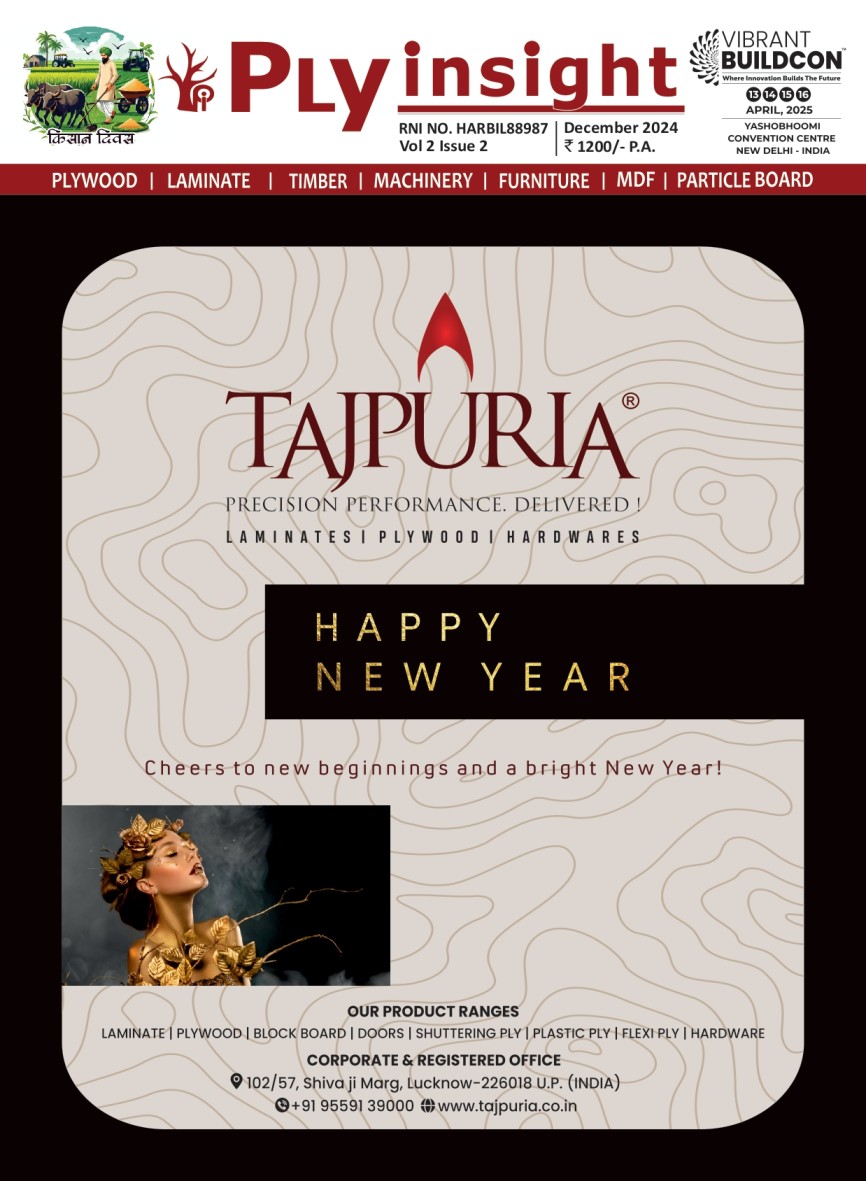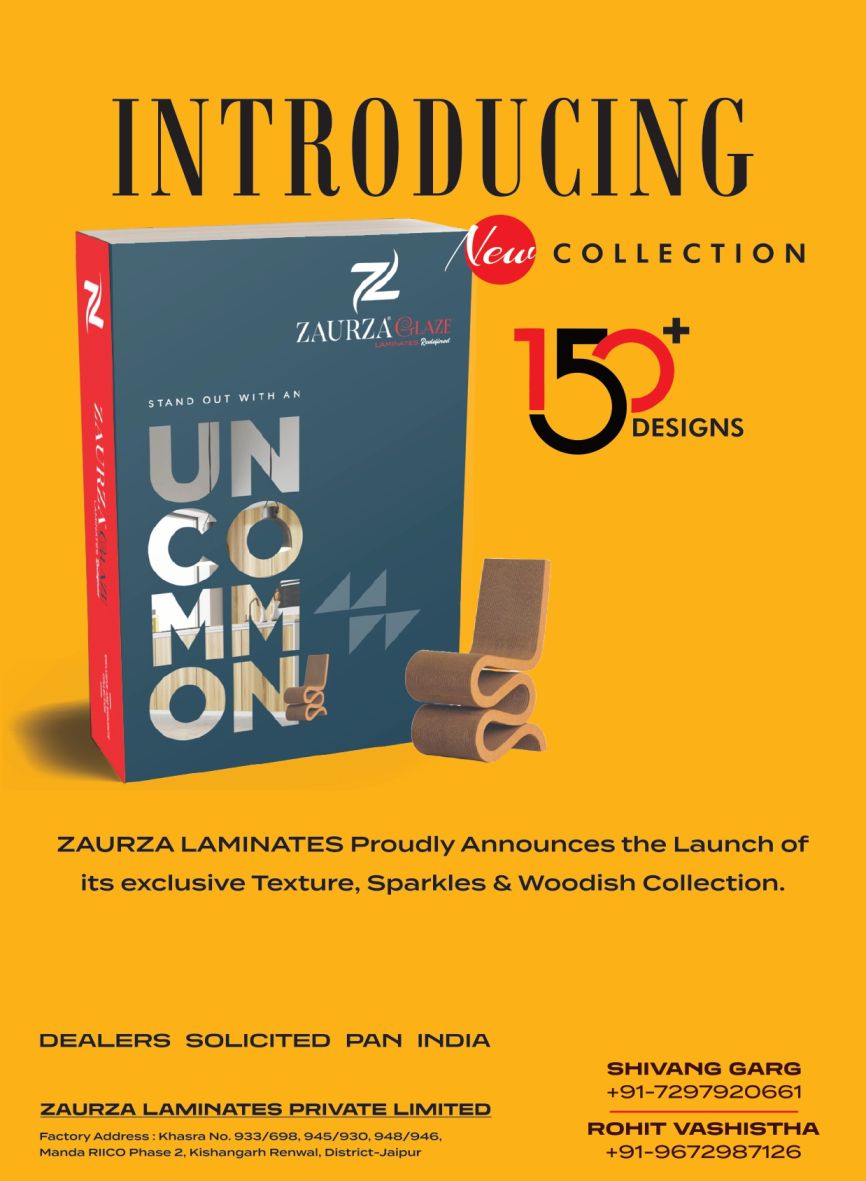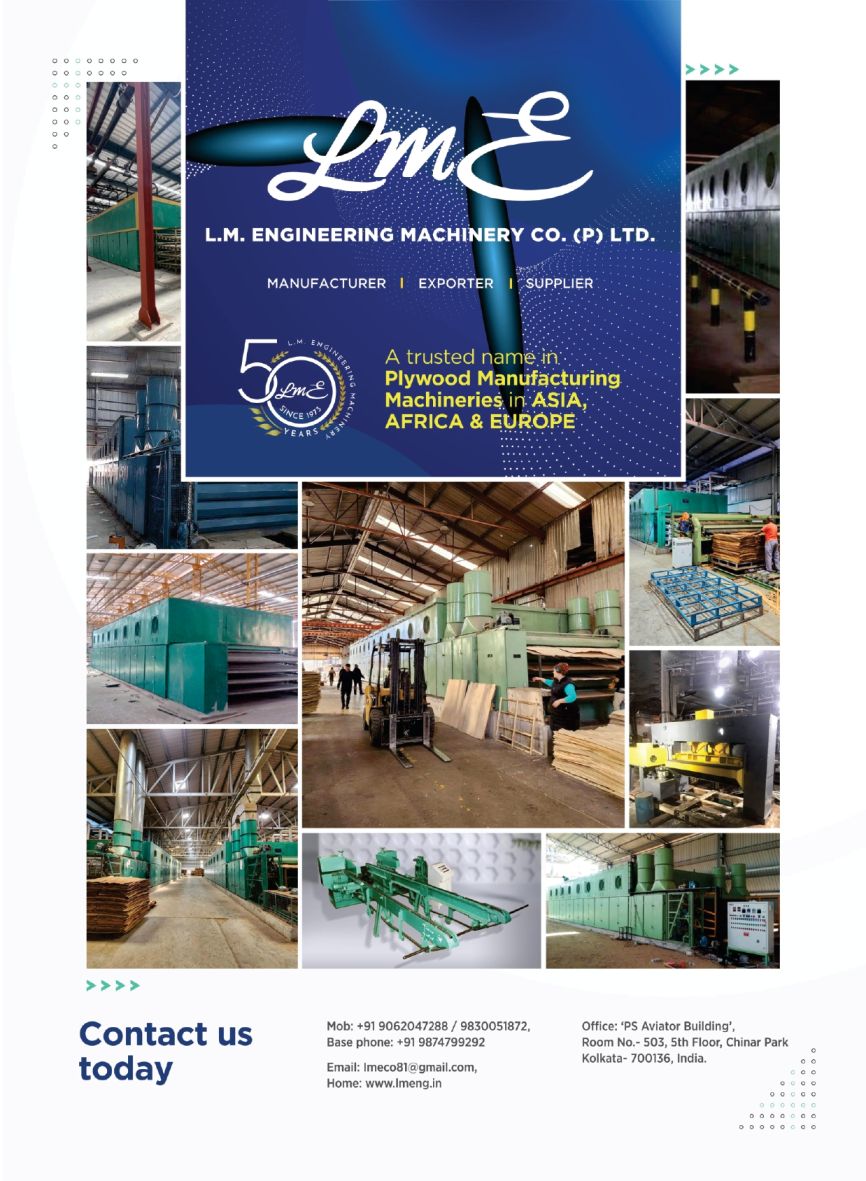
Agri-wood Needs for Small-Medium Plywood Factories – A way forward
- February 23, 2022
- 0
As the world is looking forward to revival of economies post-covid pandemic times, it is important for our Plywood Industry Sector in India, to look to the future, and contemplate the problems/situations/challenges to come, during the coming years.
Future markets will be ruled by:
- Sustainability – FSC, PEFC, and such other Chain of Custody (CoC) certifications.
- Plywood construction & manufacturing without core-gaps & overlaps.
- Low Emission – Low & Ultra-Low Formaldehyde emission standards such as CARB P2, E0, E 0.5, JIS F****, and so on… These are called the LFE (Low Formaldehyde Emission) & ULEF (Ultra Low Emission of Formaldehyde) categories.
- Guaranteed quality,branded products.
- Well documented, and well-maintained manufacturing process.
- Optimum utilisation of raw material & chemical resources.
- Resin & Glue advancements in cost-cutting & speed of manufacture (fast-curing, high moisture content, defect-free manufacturing etc.).
One of the most critical criteria for survival of our domestic plywood industry (PWI) in future will be – availability of peelable quality timber resources.
Timber requirement estimates
How do we arrive at a practical timber requirement estimate? The easiest way is to work backward, from the hot press installations across our industry. Since Eucalyptus is the most sought-after timber for weight, strength and colour considerations, let us estimate the Eucalyptus wood resource requirements.
For every 10 daylights hot press, running 24 hours:
- One production cycle needs 6,550 mm square feet of dried core veneer for assembly of 18mm thick plywood for hot pressing (1.7mm core veneer per layer).
- If the hot press produces 50 production cycles in 24 hours of work @ 25 minutes per 18mm thickness, it would need 50 X 6,550 = 3,27,500 mm square feet of core veneers at less than 6% core veneer moisture content (MC).
- Considering that 1 ton of Eucalyptus provides around 4,500 mm sq.ft. of core veneers, this press would need 3,27,500 / 4,500 = approx. 73 Tons of log purchase per 24-hour running.
- In short, every 10 daylights hot press producing 18mm plywood with Eucalyptus would require 73 T of incoming timber for core veneer per 24 hours. Say 75 T.
- If a well-managed plantation produces an average output of 20T per Ha of Eucalyptus wood every year, at a rotation of 5 years (100T), this press will require 75/100 = 0.75 Ha output of 5-year rotation, per 24-hour manufacturing day (every work day).
This shows that for every 10 daylights hot press using Eucalyptus species, timber availability should be 75 X 300 = 22,500 T, which in turn should come from 225 Ha X 5 (yrs rotation) = 1,125 Ha = 2,780 Acres of plantation land managed at 5-year rotation, which is expected to providetimber output of 20T per Ha per annum.
If there are an equivalent of 800 X 10-daylights presses in Haryana State alone, the plywood industry of the State would need to source Eucalyptus Species wood logs from 2,780 X 800 = 2,224,000 Acres (approx. 0.9 M Ha of plantations) all round the year.
Way Forward
The Forest Act, 1988 Amendment clearly lays out that WBI (wood based industries) have to look for raw material resources on their own. This makes it very clear that industries in our sector have to make their own arrangements for quality timber resources of their chosen species. Government departments are not going to involve other than for regulatory purposes whatsoever.
Some of the activities that will help PWI in the way forward:
- Managements of industries must change mindset, and start learning about clones available for different chosen species based on their requirements.
- Factories may start exploring tie-ups and buy back arrangements with farmer-groups, farmer-societies, farmer-associations and similar farmer producer organisations (FPOs) around their locations. This will also help easily make documents for &’prove’ CoC for sustainability certifications.
- Factories can also involve in value addition to farmers by arranging specific clones from recognised institutes at a subsidised rate, and by having awareness programmes related to future timber requirements and market possibilities.
- Managements can engage with their respective Agri- & Forest- administrations in order to create better plantation infrastructure and expansion of farm areas under agroforestry (AF), and also in continuously pushing for higher timber output from available AF lands.
- Managements can tie-up with FPOs in order to work on reviving degraded lands for AF plantations. This may enable farmers to go for higher girth timber with larger spacing plantations which in turn may benefit industries with the possibility of peeling face veneers from specific species such as Melia Dubia (Malabar Neem).
Associations can play a big role
PWI regional Associations can think of enhancing their role in ensuring a proper system of functioning in the sector.
By raising just R100/- per daylight, per month from factories, Association having 8,000 daylights under its membership can raise R8,00,000/- per month. This fund is more than sufficient to initiate & maintain all development, coordination works with FPOs and various other departments. This will also continuously enable automatic participation from all factories, small or big. Such initiatives will go a long way in ensuring unity, cooperation, participation and energy levels of the PWI sector in India.
Without a combined, well-coordinated approach from industries toward raw material requirement-based strategies for the future, our PWI sector will be in serious operational bottle-necks in the years to come. In view of the expansion of MDF factories across various locations in India by organised players of the sector, the smaller and medium level industries will have to look into a more serious strategy toward profitable operations, if they have to survive smoothly in future.
With the available number of factories, and organising for good quality peelable timber resources, Indian PWI can become a major hub for producing quality plywood and plyboard products of high repute.
Jai Hind!
छोटे-मध्यम प्लाइवुड कारखानों के लिए कृषि-लकड़ी की जरूरतें – आगे का रास्ता
जैसा कि दुनिया कोविड महामारी के समय के बाद अर्थव्यवस्थाओं के पुनरुद्धार की प्रतीक्षा कर रही है, भारत में हमारे प्लाइवुड उद्योग क्षेत्र के लिए, भविष्य की ओर देखना और आने वाले वर्षों के दौरान आने वाली समस्याओं/ स्थितियों/चुनौतियों पर विचार करना महत्वपूर्ण है।
भविष्य के बाजारों को इनके द्वारा शासित किया जाएगाः
- सस्टेनेबिलिटी – FSC, PEFC और ऐसे अन्य चेन ऑफ कस्टडी (COC) प्रमाणन।
- प्लाइवुड निर्माण बिना कोर – गेप और ओवरलैप के।
- कम उत्सर्जन – कम और अल्ट्रा-लो फॉर्मलाडेहाइड उत्सर्जन मानक जैसे कि CARB P2,E0, E 0.5 , JIS और इसी तरह की अन्य। इन्हें LFE (लो फॉर्मलाडेहाइड उत्सर्जन) और ULEF (अल्ट्रा लो एमिशन ऑफ द फॉर्मलडिहाइड श्रेणियां) कहा जाता है।
- गारंटीकृत गुणवत्ता, ब्रांडेड उत्पाद।
- अच्छी तरह से प्रलेखित, और अच्छी तरह से बनाने की निर्माण प्रक्रिया।
- कच्चे माल और रासायनिक संसाधनों का इष्टतम उपयोग।
- रेजीन और ग्लू की विकसीत तकनीक से लागत में कटौती और निर्माण में गति (तेजी से Curing , उच्च नमी सामग्री, दोष मुक्त निर्माण आदि)।
- भविष्य में हमारे घरेलू प्लाईवुड उद्योग (PWI) के अस्तित्व के लिए सबसे महत्वपूर्ण मानदंडों में से एक होगा – छीलने योग्य ( Peelable) गुणवत्ता वाले लकड़ी संसाधनों की उपलब्धता।
लकड़ी की आवश्यकता का अनुमान
हम लकड़ी की आवश्यकता के एक व्यावहारिक अनुमान पर कैसे पहुँचते हैं? हमारे उद्योग में लगे हुए Hot Press से पिछे का हिसाब करना सबसे आसान तरीका है। चूंकि यूकेलिप्टस वजन, मजबूती और रंग के लिहाज से सबसे अधिक इस्तेमाल की जाने वाली लकड़ी है, इसलिए आइए हम यूकेलिप्टस की लकड़ी की संसाधन आवश्यकताओं का अनुमान लगाएं।
हर 10 Daylight के लिए, 24 घंटे चलने वाला हॉट प्रेस:
- होट प्रेस के एक उत्पादन चक्र में 18 mm मोटी प्लाईवुड (प्रति परत 1.7 mm कोर वीनीयर) के संयोजन के लिए 6,550 mm वर्ग फुट सूखे कोर वीनीयर की आवश्यकता होती है।
- यदि हॉट प्रेस 24 घंटे के काम में 25 मिनट प्रति 18 mm मोटाई में 50 उत्पादन चक्र का उत्पादन करता है, तो उसे 6 प्रतिशत से कम नमी वाली 50 x 6,550 = 3,27,500 mm वर्ग फुट कोर विनियर की आवश्यकता होगी।
- यह ध्यान में रखते हुए कि 1 टन सफेदा से लगभग 4,500 mm वर्ग फुट प्राप्त करता है। कोर विनियर की, इस प्रेस को 3,27,500/4,500 = लगभग 73 टन लॉग खरीद की आवश्यकता होगी प्रति दिन 24 घंटे चलने पर।
- संक्षेप में, यूकेलिप्टस के साथ 18 उउ प्लाईवुड का उत्पादन करने वाले प्रत्येक 10 डेलाइट हॉट प्रेस को प्रति 24 घंटे में कोर विनियर के लिए 73 टन लकड़ी की आवश्यकता होगी। 75 टन कह सकते हैं।
- यदि एक अच्छी तरह से प्रबंधित वृक्षारोपण हर साल यूकेलिप्टस की लकड़ी का 20 टन प्रति टेक्टेयर का 5 साल (100 टन) के रोटेशन पर औसत उत्पादन करता है, तो इस प्रेस को 5 साल के रोटेशन के 75/100 = 0.75 हेक्टेयर उत्पादन की आवश्यकता होगी, प्रति 24-घंटे निर्माण दिवस (प्रत्येक कार्य दिवस) के लिए।
इससे पता चलता है कि यूकेलिप्टस प्रजातियों का उपयोग करते हुए प्रत्येक 10 Daylight के लिए, लकड़ी की उपलब्धता 75 x 300 = 22,500 टन होनी चाहिए, जो बदले में 225 हेक्टेयर 5 (वर्ष रोटेशन) = 1,125 हेक्टेयर = 2,780 एकड़ वृक्षारोपण भूमि 5 वर्श रोटेशन पर प्रबंधित होनी चाहिए। जहां से प्रति वर्ष 20 टन प्रति हेक्टेयर लकड़ी उत्पादन मिलने की उम्मीद है।
यदि अकेले हरियाणा राज्य में 800 x 10-डेलाइट प्रेस के बराबर मानते हैं, तो राज्य के प्लाईवुड उद्योग को 2,780 x 800 = 2,224,000 एकड़ (लगभग 0.9 मिलियन हेक्टेयर वृक्षारोपण) से यूकेलिप्टस प्रजाति की लकड़ी के लट्ठे प्राप्त करने होंगे।
आगे का रास्ता
वन अधिनियम, 1988 का संशोधन स्पष्ट रूप से बताता है कि WBI (लकड़ी आधारित उद्योग) को अपने दम पर कच्चे माल के संसाधनों की तलाश करनी होगी। इससे यह बहुत स्पष्ट हो जाता है कि हमारे क्षेत्र के उद्योगों को अपनी चुनी हुई प्रजातियों के गुणवत्तापूर्ण लकड़ी संसाधनों के लिए अपनी व्यवस्था स्वयं करनी होगी। सरकारी विभाग नियामक उद्देश्यों के अलावा अन्य कहीं शामिल नहीं होने जा रहे हैं।
कुछ गतिविधियाँ जो WBI को आगे बढ़ने में मदद करेंगी:
- उद्योगों के प्रबंधन को मानसिकता बदलनी चाहिए, और विभिन्न चुनी हुई प्रजातियों के लिए उनकी आवश्यकताओं के आधार पर उपलब्ध क्लोनों के बारे में सीखना शुरू करना चाहिए।
- फैक्ट्रियां अपने स्थानों के आसपास किसान-समूहों, किसान-समाजों, किसान-संघों और इसी तरह के किसान उत्पादक संगठनों (FPO) के साथ गठजोड़ और बायबैक व्यवस्था की खोज शुरू कर सकती हैं। यह स्थिरता प्रमाणपत्रों के लिए COC लिए आसानी से दस्तावेज बनाने और ‘साबित’ करने में भी मदद करेगा
- फैक्ट्रियां मान्यता प्राप्त संस्थानों से रियायती दर पर विशिष्ट क्लोन की व्यवस्था करके और भविष्य की लकड़ी की आवश्यकताओं और बाजार की संभावनाओं से संबंधित जागरूकता कार्यक्रम आयोजित करके किसानों के मूल्यवर्धन में भी शामिल हो सकती हैं।
- प्रबंधन अपने संबंधित कृषि और वन-प्रशासन के साथ जुड़ सकते हैं ताकि बेहतर वृक्षारोपण बुनियादी ढांचा तैयार किया जा सके और कृषि वानिकी (AF) के तहत कृषि क्षेत्रों का विस्तार किया जा सके, और उपलब्ध। AF भूमि से लकड़ी का अधिकतम उत्पादन के लिए लगातार जोर दिया जा सके।
- प्रबंधन एफपीओ के साथ गठजोड़ कर सकते हैं ताकि ।थ् वृक्षारोपण के लिए अवक्रमित भूमि को पुनर्जीवित करने पर काम किया जा सके। यह किसानों को बड़े अंतराल वाले वृक्षारोपण के साथ जाने में सक्षम कर सकता है। जो बदले में मेलिया दुबिया (मालाबार नीम) जैसी उच्च परिधि हपतजी लकड़ी के लिए विशिष्ट प्रजातियों से फेस वीनीयर को छीलने की संभावना वाले उद्योगों को लाभान्वित कर सकता है।
संघ बड़ी भूमिका निभा सकते हैं
PWI क्षेत्रीय संघ इस क्षेत्र में कामकाज की एक उचित प्रणाली सुनिश्चित करने में अपनी भूमिका बढ़ाने के बारे में सोच सकते हैं।
सिर्फ रु. 100/- प्रति माह प्रति डेलाइट जुटाकर, कारखानों से प्रति माह, 8,000 वाले संघ अपनी सदस्यता के तहत 8,00,000/- प्रति माह जुटा सकते हैं। यह फंड एफपीओ और विभिन्न अन्य विभागों के साथ सभी विकास, समन्वय कार्यों को शुरू करने और बनाए रखने के लिए पर्याप्त से अधिक है। यह छोटे या बड़े सभी कारखानों से लगातार स्वचालित भागीदारी को भी सक्षम करेगा। इस तरह की पहल भारत में PWI क्षेत्र की एकता, सहयोग, भागीदारी और ऊर्जा के स्तर को सुनिश्चित करने में एक लंबा रास्ता तय करेगी।
भविष्य के लिए कच्चे माल की आवश्यकता-आधारित रणनीतियों की ओर उद्योगों से संयुक्त, अच्छी तरह से समन्वित दृष्टिकोण के बिना, हमारा PWI क्षेत्र आने वाले वर्षों में गंभीर परिचालन बाधाओं में होगा। क्षेत्र के संगठित खिलाड़ियों द्वारा भारत में विभिन्न स्थानों पर एमडीएफ कारखानों के विस्तार को देखते हुए, छोटे और मध्यम स्तर के उद्योगों को भविष्य में सुचारू रूप से जीवित रहने के लिए लाभदायक संचालन की दिशा में अधिक गंभीर रणनीति पर गौर करना होगा।
कारखानों की उपलब्ध संख्या के साथ, और अच्छी गुणवत्ता वाले छीलने योग्य लकड़ी के संसाधनों के आयोजन के साथ, भारतीय PWI उच्च प्रतिष्ठित गुणवत्ता वाले प्लाईवुड और प्लाईबोर्ड उत्पादों के उत्पादन के लिए एक प्रमुख केंद्र बन सकता है।
जय हिन्द!































































